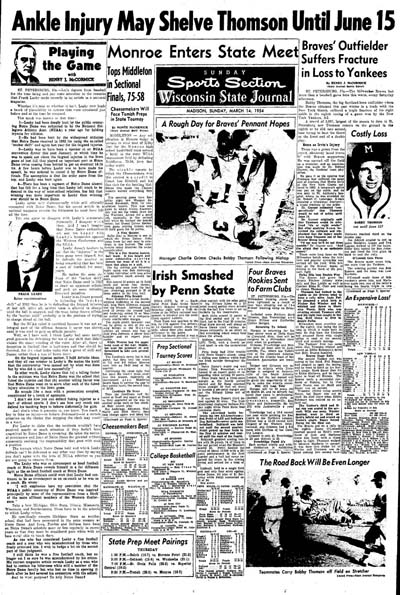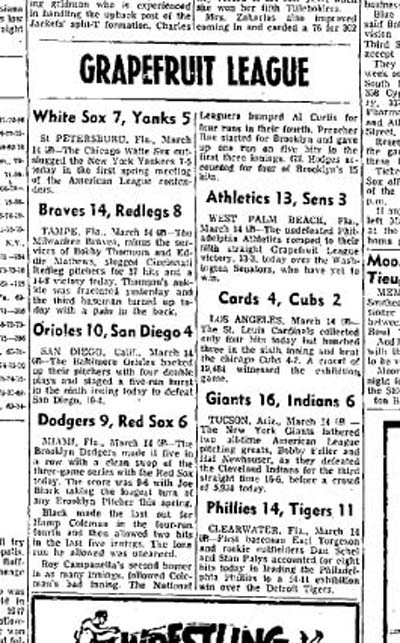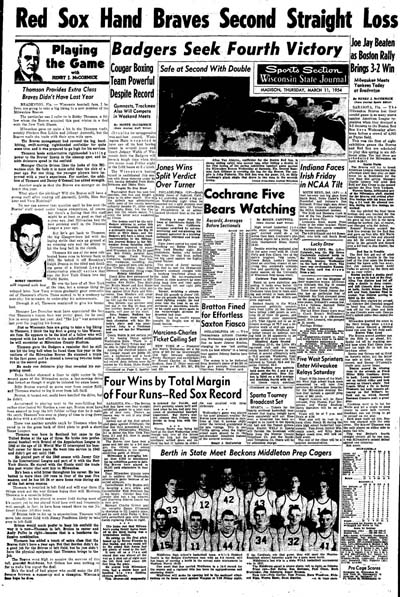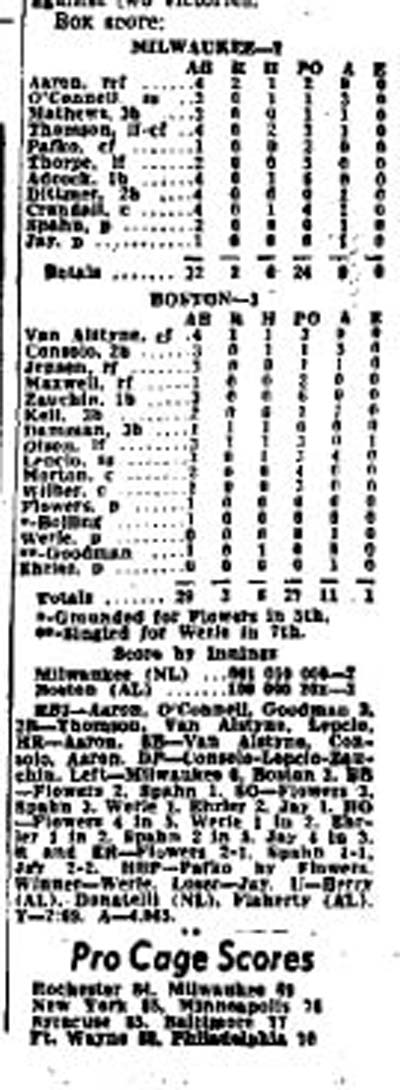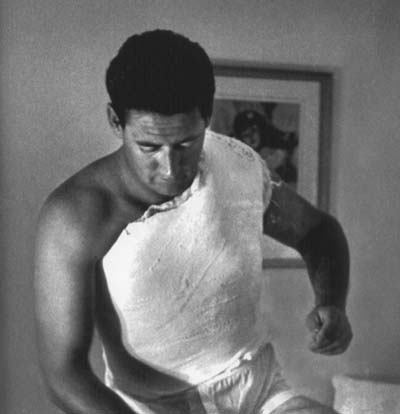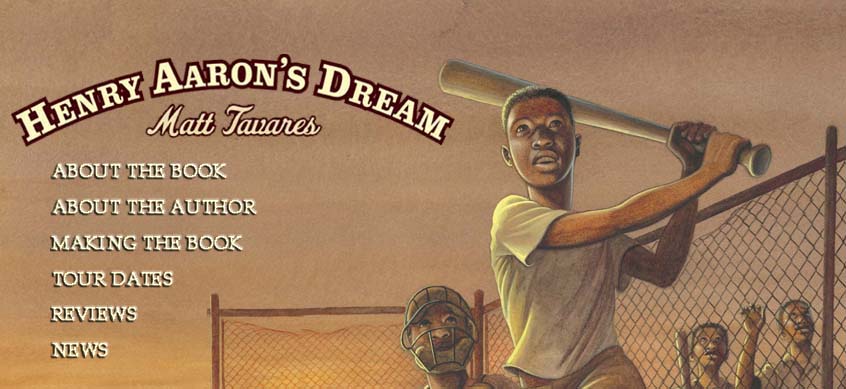
| WRITING
THE BOOK I started writing Henry Aaron's Dream in September of 2007, just after I finished all the illustrations for Lady Liberty: A Biography, written by Doreen Rappaport. Lady Liberty was my first non-fiction book. There was a ton of research and fact-checking involved, and it was more difficult than any other book I had worked on. But once I got the hang of it, I really loved the whole process. It made me want to do more non-fiction books. My original plan was for this book to cover from Henry Aaron's childhood right up until the moment he surpassed Babe Ruth and became Major League Baseball's all-time home run king. But as I started writing, I found that I was fascinated by the story of his early years, and decided to focus the book on Henry Aaron's steadfast determination to pursue his childhood dream of becoming a big-league baseball player, even when it seemed impossible. What Henry Aaron accomplished late in has career on his way to becoming baseball's home run king was so historic and spectacular, the rest of his story is often forgotten. But the story of Henry Aaron is about so much more than the 755 home runs he hit. Henry Aaron's Dream tells the story of a kid from the segregated south who dreamed of making it to the major leagues, even though he wasn't even allowed to play on any of the baseball diamonds in his own city. It's about the impact that Jackie Robinson had on a generation of African-American kids, including 13-year-old Henry Aaron, when he broke baseball's color barrier in 1947. Ultimately, Henry Aaron's Dream is about the determination and perseverance that carried Henry Aaron from Mobile, Alabama all the way to the big leagues. ILLUSTRATING THE BOOK Here's a step-by-step look at how I made the illustration of Henry Aaron in his first pofessional at-bat, playing for the Braves class-C minor league team in Eau Claire, Wisconsin. This was the first time Henry Aaron ever faced a white pitcher. He was nervous, because he had been told for so long that white ballplayers were better than black ballplayers. I decided to show the scene from behind the batter, so the reader was looking at the pitcher from the same point of view as Henry Aaron. I found some footage of him swinging and stopped the video just at the right moment. That way I could be sure I was showing an accurate depiction on Henry Aaron's swing. One nice thing about using a frame from a movie is that it's blurry, and it leaves me plenty of room to create my own image. I used photographs and film footage of Henry Aaron mostly for historical acuracy, and for likeness. Here's my first sketch: 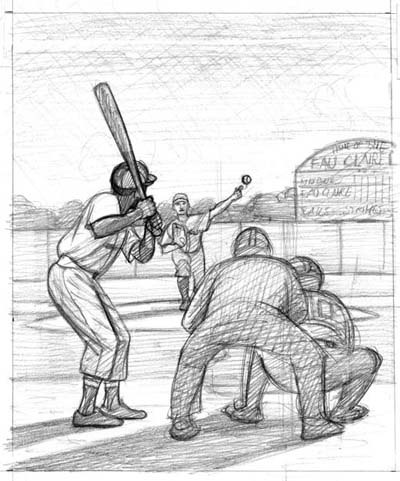 I liked this sketch, but after seeing it up on my wall for a while I felt like it didn't capture the intensity of the moment. I decided to zoom way in, so the reader sees the scene from right behind Henry Aaron, like you're right there in the picture. I posed for a few photos, to help get that up-close point of view. I often pose myself as the characters in my books, even for characters that look nothing like me. For this one, I looked at photos and movies of Hank Aaron to make sure it looked like him and his swing, but I used the photos of myself to help get the perspective right, and to help with details like hands and folds in the fabric of the uniform. 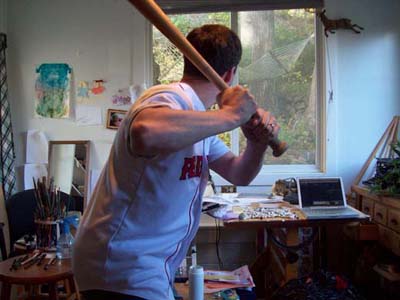 Here's my second sketch: 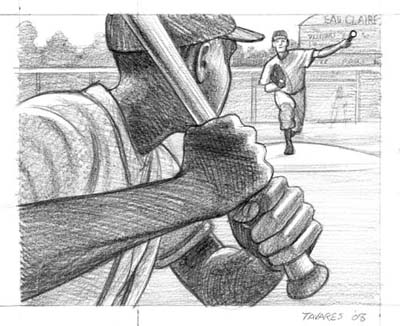 I think this sketch does a much better job of capturing the intensity of this moment, and my art director agreed. Being a nonfiction book, there were little details in every picture that I needed to research. For this one, I found pictures of the Eau Claire Bears 1952 uniforms, found out who they played in Henry Aaron's first game, and found pictures of their ballpark. Here's how that illustration looks in the book: 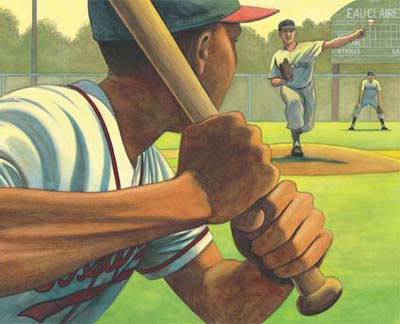 |
THE
TRUE STORY OF HENRY AARON'S FIRST
START FOR THE BRAVES According
to
just about every book
written about Henry Aaron,
here's how he first broke into the Braves' starting lineup:
This
was
a major moment in Henry
Aaron's journey to the big
leagues, and it's a wonderful story,
especially the part about the great Ted Williams simply hearing the home run, and knowing
that this 20-year-old kid was something special. So of
course I wanted to write about
it in
Henry Aaron's Dream.
The problem came when I tried to illustrate it. I decided to show Henry in the dugout, seeing his name in a major-league starting lineup for the very first time. For this picture to work, his name needed to be legible, which meant that all the other names on the lineup chart also needed to be legible, which meant that I somehow had to find the lineups from the March 14, 1954 spring training game between the Milwaukee Braves and the Boston Red Sox. I found digitized
archives of a couple Wisconsin newspapers that covered the Milwaukee
Braves
1954 spring training games. Here's the March 14, 1954 edition of the
Wisconsin State
Journal, featuring the bold headline, "Ankle Injury May Shelve Thomson
Until June
15".
So
far, so good. Now I just needed to
find the box score from the Red Sox-
Braves game in the next day's paper and I'd
be
done.
According
to
this newspaper,
the Braves did not play
the Red Sox in Sarasota on March 14, 1954! They played the Cincinnati
Redlegs
in Tampa, while the Red Sox were in Miami playing the Dodgers.
I searched through all
the Braves-Red Sox games in the schedule, and couldn't find any home
runs hit by Hank Aaron. Then finally I found it. The Braves and Red Sox
played a make-up game in Sarasota on March 10:
Henry
Aaron's
name
was
in
the
starting
lineup
for the very
first time on March 10, 1954, in a spring training game against the
Boston Red Sox in
Sarasota, three days before Bobby Thomson broke his ankle. Here's
a
close-up of the
box score. Aaron is batting leadoff and playing right field (he
wouldn't
take
over
the
left
field
job until March 29) and Bobby Thomson is batting
cleanup, starting in left field:
Henry
Aaron
hit a home run that day,
and his name remained in the starting lineup for most of the next
twenty-three seasons. This was certainly a big day in young Henry
Aaron's life. But it didn't happen quite the same way as everyone says
it happened.
I did a little more research in the
Boston newspapers and
found that Ted Williams broke his collarbone on March 1, 1954. He
underwent surgery in
Boston on March 9, one day before this game. This is what Ted Williams
looked like on March 10, 1954:
He
was not released from the hospital until the following week. Ted
Williams certainly may
have remembered hearing Hank Aaron hit a
home run,
but he wasn't there for this particular
home run on March 10, 1954.
If
there were no illustrations in Henry
Aaron's Dream,
I
probably never would have stumbled upon this little piece of history.
If I hadn't decided to draw a picture of the lineup chart, I might
never have looked at the old newspapers. But I'm glad I did. There was
something incredibly exciting about this process of digging through old
newspapers, finding out what really happened. And that
excitement is part of what I
love about making
nonfiction books. There's a
detective-work aspect to it, and oftentimes
my
research takes me to places I did not expect to go.
In
the end, I included this moment in
Henry Aaron's Dream,
because
whether
it
was
March
10
or
March 14, it was a major moment in
Henry
Aaron's life- even if Ted Williams wasn't
there.
I
relied
mostly
on
the
actual
box
scores
and articles from the 1954 newspapers.
|
        |
